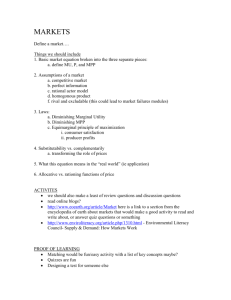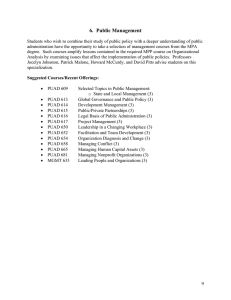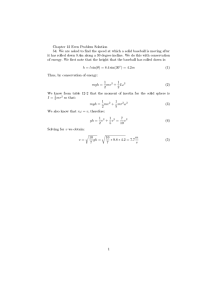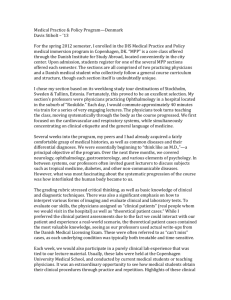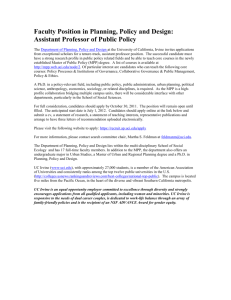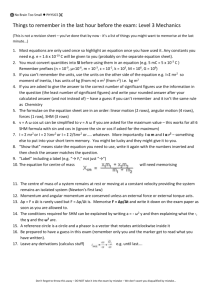TRAINING PUBLIC OFFICIALS FOR THE TWENTY-FIRST CENTURY
advertisement
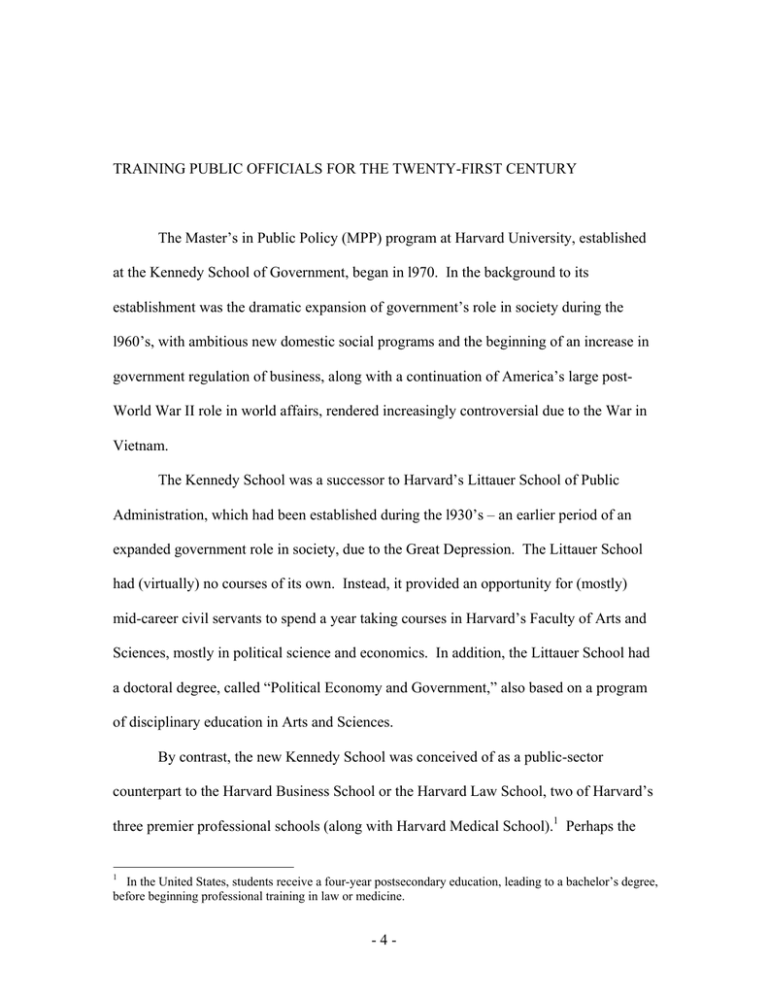
TRAINING PUBLIC OFFICIALS FOR THE TWENTY-FIRST CENTURY The Master’s in Public Policy (MPP) program at Harvard University, established at the Kennedy School of Government, began in l970. In the background to its establishment was the dramatic expansion of government’s role in society during the l960’s, with ambitious new domestic social programs and the beginning of an increase in government regulation of business, along with a continuation of America’s large postWorld War II role in world affairs, rendered increasingly controversial due to the War in Vietnam. The Kennedy School was a successor to Harvard’s Littauer School of Public Administration, which had been established during the l930’s – an earlier period of an expanded government role in society, due to the Great Depression. The Littauer School had (virtually) no courses of its own. Instead, it provided an opportunity for (mostly) mid-career civil servants to spend a year taking courses in Harvard’s Faculty of Arts and Sciences, mostly in political science and economics. In addition, the Littauer School had a doctoral degree, called “Political Economy and Government,” also based on a program of disciplinary education in Arts and Sciences. By contrast, the new Kennedy School was conceived of as a public-sector counterpart to the Harvard Business School or the Harvard Law School, two of Harvard’s three premier professional schools (along with Harvard Medical School).1 Perhaps the 1 In the United States, students receive a four-year postsecondary education, leading to a bachelor’s degree, before beginning professional training in law or medicine. -4- Harvard Business School was the closest analogy the Kennedy School’s founders had in mind. Business, unlike law and medicine, is not a licensed profession – people do not need a Master’s of Business Administration degree to become businesspeople, in the way they need degrees in medicine or law to enter those professions. But, beginning around the l920’s in the United States, the Harvard Business School, and other masters of business administration programs, succeeded in transforming a situation where few saw any need for aspiring businesspeople to have any professional training in business into one where such a degree was a valued, though not required, credential. Successfully running a business, the promoters of professional business education argued, required knowledge and skills that could appropriately be taught in the classroom, and that would give young people who had studied business administration a leg up in being more successful at business. The founders of the Kennedy School MPP program had a similar vision. They were motivated by the view that the role of government in American society was becoming increasingly important and that it was increasingly important for government to have access to well-trained people who could analyze and deal with increasingly complex public problems. They never expected that a public policy degree would become a prerequisite for public service, as a medical degree is for doctors. But they did hope that it would over time become a significant advantage for young people going to work in the public sector and that, over time, an increasing proportion of civil servants would come to have such a degree (not necessarily from Harvard, of course – public policy degree programs were established at a number of other universities around the same time). They also expected that the MPP degree (at the Kennedy School and other -5- universities) might help the government create an elite career civil service corps, analogous to the elite civil service coming out of Oxford/Cambridge in Britain or Tokyo University in Japan, as opposed to the American tradition where few graduates of top universities spent their careers in government, though a larger number did brief periods of government service as senior politically appointed officials (at the assistant secretary or cabinet secretary levels). The original curriculum of the MPP program included a “core curriculum” of required courses, which took up most of students’ first year, and then a large number of elective courses (including courses outside the Kennedy School) that students could take during their second year. The second year also included a large written assignment, undertaken for a real client as a sort of consulting project, called the “policy analysis exercise.” The key concept underlying the original MPP core curriculum was what the Kennedy School (and others) called “policy analysis” – that is to say, the use of social science tools, particularly microeconomics and econometrics, to make judgments about what the appropriate government policy should be in some policy area, such as health or environmental policy. The idea was to equip students to answer questions such as, “What level of health protection should an environmental regulation for asbestos require?”, “Are longer prison sentences a good way to combat crime?”, or “When, if ever, are limits to free trade justified?” In the minds of much of the School’s original faculty, the ideal first job for an MPP graduate would be as a special assistant to a senior agency official and an ideal later job would be the Assistant Secretary (senior official) for Policy Planning and Evaluation in a major government department. -6- The initial core curriculum was heavily centered on microeconomics, statistics, and econometrics. All students took two semesters of microeconomics (with a heavy emphasis on cost-benefit analysis), two semesters of statistics and econometrics (with an emphasis on techniques for program evaluation), and two semesters of “analytic methods” (a grab-bag of decision theory, linear programming, queuing theory, difference equations, and other miscellaneous analytic techniques). In addition, there was one course, called “political and organizational analysis,” that provided what the course itself called the “missing chapter” from the rest of the core curriculum – training in figuring out whether the political system was likely to adopt the proposals the policy analyst developed and whether government organizations were likely to be able to implement them. From this mixture, students got the message: “We learn in our economics and statistics courses what the government should do, and we learn in our political/organizational analysis course how to manipulate the government to get it to do what we think they should.” Unlike the Harvard Business School, the Kennedy School did not exclusively use the case method in the classroom. In the initial core curriculum, the case method was used only in the political and organizational analysis course. As the School began to develop management courses, the case method was (predominantly) used there. It was also used almost exclusively when executive education was developed. The basic pedagogical justifications for the case method were two. One was that the greater degree of student involvement in the learning experience that the case method provided meant that students retained more of the information presented in the classroom than if they had received the same material in lecture format. Since less information is communicated in -7- a class discussion than in lectures, there is a tradeoff between the quantity of information and retention of information presented. (Student retention of information from cases might be greater for another reason, namely that it is easier for people to remember stories than abstractions.) The second justification was that discussion of real cases gave students more practice in dealing with actual situations similar to those they would face on the job, a particularly important consideration for professional education. Another way of putting this point is to note that, in many of the courses students took as undergraduates, the hard thing was mastering the theory. In management, by contrast, the hard thing is not mastering the theory but getting better at using the theory to help deal with concrete situations. In the thirty-odd years since the MPP program began, there have of course been significant changes, both involving the School’s student body and, more importantly, involving the public and non-profit sectors to which the School relates. These have produced some relatively significant changes in the School’s curriculum and course offerings. They also suggest the need for further evolution, for the appropriate training of government officials for the twenty-first century. (1) The hope (or expectation) of the School’s founders that an MPP degree would come to be regarded as an important credential for people going to work for government has, basically, not been realized. Kennedy School graduates have had little trouble getting jobs, and a Kennedy School MPP is regarded by people in government as a “good” degree – possibly in significant measure because it is a Harvard degree – but an MPP degree does not, as of yet, come close to the cachet in government that an MBA has -8- in business. (Indeed, often in government an MBA degree, or a law degree, is still seen as being as valuable, or in some cases more valuable, as an MPP degree.) (2) Additionally, the hope (or expectation) of the School’s founders that essentially all MPP graduates would seek work in government was not realized, and even less so that graduates working in government would in significant numbers become career civil servants who would come to make up the nucleus of an elite civil service corps. Most of the MPP program’s early graduates, though not all, did take their first job in government, but most left within a few years, some for good, and others somewhat in the mode, familiar in the United States, of “in-and-outers,” people who alternated between periods in government (generally in politically appointed rather than career positions) and periods in the private sector. In the last two decades, the underlying trend has also been for fewer MPP graduates to take even their first jobs in government. Besides government, the two major places MPP graduates take their first jobs are nonprofit organizations (hardly noticed by the School’s founders) and for the public-sector divisions of private consulting/information technology firms, such as Accenture or EDS. A smaller group has gone into investment banking, mostly (though not exclusively) public finance. Even now, however, only a small percentage of MPP graduates go into jobs that have no connection to the public or non-profit sectors at all. The decline in the proportion of MPP students taking their first jobs in government corresponds to the declining competitiveness of government as an employer of young professionals over the same period. This occurred both because government salaries became increasingly unattractive financially – the government wage scale is much more egalitarian than in the private sector, offering blue collar workers above- -9- average wages and professionals below-average wags – and because American culture was becoming increasingly unfavorable to government service. (3) Partly as a result of corporate “downsizing” activities that became widespread starting in the l980’s, younger people began to see themselves as having many jobs, and many employers, during their careers. The idea of starting with one employer right out of university and staying with that employer for an entire career – what might be called the “Japanese model,” though a version of it was common in large American companies as well for many years – became increasingly foreign to young people. Many MPP graduates saw themselves as spending periods of their careers in the public, non-profit, and private sectors. (4) Mid- and senior-level career officials in government, attending Kennedy School executive education programs (shorter, non-degree programs lasting one to several weeks) that began in a serious way during the l980’s, expressed little interest in learning the policy analysis skills the MPP core curriculum. Instead, they wanted to learn management, negotiation, and leadership skills. Analogously, starting in the l990’s, the MPP program began accepting fewer and fewer students directly out of undergraduate bachelor’s programs, but rather students with 1-4 years work experience prior to coming to the Kennedy School. These students as well were more interested than their predecessors, with no work experience, in learning about management and leadership. (5) A larger proportion of MPP students come from outside the United States, a trend that has been accelerating in recent years. Currently, about 20% of the MPP class is non-U.S. It should also be noted that in the late l990’s the Kennedy School established another two-year program, the MPA/ID program (Master’s in Public Administration in - 10 - International Development), which also has a core curriculum, and is even more heavily oriented towards economics, at a more advanced quantitative level than the MPP core curriculum. About 70% of its students are non-U.S. In response to these changes, the MPP curriculum in general and the core curriculum in particular have changed significantly over the past thirty years. The changes have been incremental, but there have been enough increments that the curriculum today ends up looking quite different from that of l970: (1) Probably the most important single change is the increased role of management and leadership in the curriculum. By the end of the l970’s, the School had introduced two semesters of public management into the required core curriculum. (This later got cut back to one semester.) In the l980’s, the School began to expand its faculty in public management and to offer additional courses in public management beyond the introductory core classes. (A fairly large proportion of the management faculty consisted of lecturers, who were ex-practitioners, rather than academics, though during the l990’s the School recruited an increasing number of academics.) By 2003, in addition to the introductory management course, the School also offered follow-on courses in areas such as human resources management, negotiations, operations management, performance measurement, and so forth. Also, the School began during the l990’s to teach non-profit management. (2) In the l990’s, the School established an entire area of courses called “Politics, Advocacy, and Leadership.” (PAL) The old required political and organizational analysis course was replaced by the equivalent of one and one-half semesters of selected topics (“modules” – less-than-semester courses) in these areas, including modules in - 11 - leadership, negotiation, political organizing (for advocacy groups/NGO’s), and advocacy. The pedagogy was a mixture of some cases and some traditional lectures, but many “hands-on” exercises, where students negotiated among themselves or organized issue campaigns. Follow-on courses in the PAL area included courses on the media and on running for public office. (3) A course on ethics was introduced into the core curriculum. (This was based on moral and political philosophy, applied both to issues of substantive public policy such as affirmative action or economic regulation and to issues of “professional ethics” such as how one should behave as a career public official if one disagrees with policies that have been decided.) During the l990’s, the School hired several faculty members able to teach ethics and political philosophy, including, in 2003, one of the leading academic moral philosophers alive today, and a number of follow-on courses in this area were added to the curriculum. (4) The intellectual and “cultural” domination of microeconomics and statistics/econometrics in the curriculum declined. The course teaching decision and optimization theories was eliminated from the core curriculum, though some of the material was transferred to other courses. Economics and statistics were still an important part of the curriculum, but few students would have seen the core curriculum as being essentially “about” teaching these subjects. Interestingly, the expression “policy analysis” largely disappeared from the vocabulary of the core curriculum. (5) Towards the end of the l990’s, the School made an important change in the core curriculum by introducing a new version of a “spring exercise” project (that had existing off and on, in different forms, in the core curriculum since the l970’s) as a - 12 - capstone to the students’ first year. The new spring exercise was a highly imaginative pedagogical device. For the last two weeks of the students’ first year (the other core courses ended early), the entire first-year class worked fulltime on the same “big” public problem. (Since sping exercise began, these topics have included pension reform, AIDS in Africa, global warming, bioterrorism/smallpox, and, this year, Afghanistan reconstruction). During the first week, the students write an individual memo on a subject related to the topic. For the second week, the students are divided into teams of five to work together to prepare a briefing (and a “briefing book”) on the topic for a senior government official, such as Secretary of State Powell (on AIDS in Africa). Members of the faculty with significant government experience role-play the senior government official and behave as they believe the official would behave if it were a “real” briefing. Spring exercise seeks to integrate the various aspects of the core curriculum, as well as to help the students develop real-life presentation skills. (6) The School has responded to internationalization mainly by introducing a significant number of internationally oriented follow-on courses. In addition to many course offerings in international development and international trade, the School also has quasi-regional courses on the European Union and on China. However, the School has generally resisted developing specific expertise in countries or regions, directing interested students to courses at other parts of Harvard. A larger number of cases taking place outside the United States have been introduced into public management courses in particular. It may be noted, however, that many of the non-U.S. students – perhaps especially Japanese students – state that one of their reasons for studying in the United - 13 - States is to learn more about American culture and society, and that they don’t necessarily want more explicitly “international” material. (7) In response to the increasing attractiveness of private sector jobs during the l990’s, the School – at least the Dean, and many though not all the faculty – has consciously attempted over the last decade to emphasize its public service mission. Dean Nye has frequently stated, “We have no desire to be the second-best business school in Cambridge.” The School has initiated programs to help students taking government or other public service jobs pay back student loans they have taken, to provide School-sponsored summer job internships with organizations that cannot afford to pay, and to present students messages expressing an expectation that they will be engaged in public service jobs for a significant part of their careers. The Kennedy School is by far the largest public policy program in the United States, in terms of number of faculty and number of students. Most other public policies schools are dominated by economists and econometricians, with a small number of faculty teaching management and/or politics. Almost none have any advanced courses in management or politics to speak of. Most have no faculty teaching ethics. Given these changes over the decades, what challenges remain for the MPP curriculum? They are, in my view, the following: (1) We teach virtually nothing about contracting or contract management. Yet 40% of U.S. federal government discretionary spending goes to buying products and services from the outside. Over time, for more and more government organizations (such as the Department of Defense, the Department of Energy, the Internal Revenue Service, or the National Aeronautics and Space Administration), contracting has become a core - 14 - competency for government. In addition, many of our students spend time working for government contractors, often as their first job out of the Kennedy School. Research and curriculum development about contracting is clearly a high priority. (It should be noted that the Kennedy School’s deficiencies in this area correspond to the government’s own deficiencies in giving this subject the attention and resources it deserves.) (2) More broadly, we teach relatively little about collaboration across organizational boundaries – be it across federal government organizations (as in egovernment projects that involve several agencies or intelligence gathering about terrorists), between central government and local government organizations, or between governments/non-profits/private organizations. We do have a course that discusses work in teams as a central theme, though it is mainly in the context of groups spanning different parts of the same organization. There is beginning to be some scholarly work on cross-organizational collaboration (there is more work, coming out of organizational behavior research, on team behavior and performance); the Kennedy School is just beginning a curriculum development effort in the area of “collaborative governance.” (3) We still grapple with “teaching leadership.” There remains a very high demand, even among MPP’s and even more among other students, including those in executive education, for courses with the word “leadership” in them. For many years, we have had a highly popular basic course on leadership that reflects one, somewhat idiosyncratic view of the skills leaders need. Many members of our faculty are skeptical of leadership studies as a scholarly field; others suggest that “leadership can’t be taught.” Many students report, however, that they have learned a great deal from leadership courses; some have even seen these courses as life-changing experiences for them. - 15 - (4) We continue to wonder whether there is more place in our curriculum for courses taught by people trained in psychology and history. We have no tenured faculty who are psychologists, though we have a number of junior faculty teaching management at the School who have psychology degrees, and we have been attempting to recruit a senior person with the same background. Separately, we have economists, including tenured faculty interested in “behavioral economics” applying psychology to the study of substantive economic and hence public policy problems, and we have one junior faculty economist who has studied psychology. We have one tenured faculty historian, and we have for many years had a course called “The Uses of History,” which discusses how one may use, and misuse, historical reasoning in thinking about public policy issues. But there is unease among some that we don’t appropriately mix history into our curriculum, and a fear that our students are largely ignorant of history. (5) We continue to experiment with pedagogy, particularly forms of experiential learning other than cases. The most significant pedagogical innovation in the last twenty years in the MPP program has been spring exercise. Interestingly, the Policy Analysis Exercise the students write during their second year has remained largely unchanged since l970. Beyond the case method, we continue to work with various pedagogical methods to develop job-related skills, such as courses that require students to organize a political effort, to give a press conference, or to write a press release. Despite these issues, I continue to believe that the MPP curriculum prepares students for government service far better than does a course of studies in any other professional area (such as law or business), and also far better than it did in l970. While the School has not been as successful as it wished in transforming the nature of public - 16 - service, it has done a good job preparing students interested in government service for the special challenges of such jobs. - 17 -
